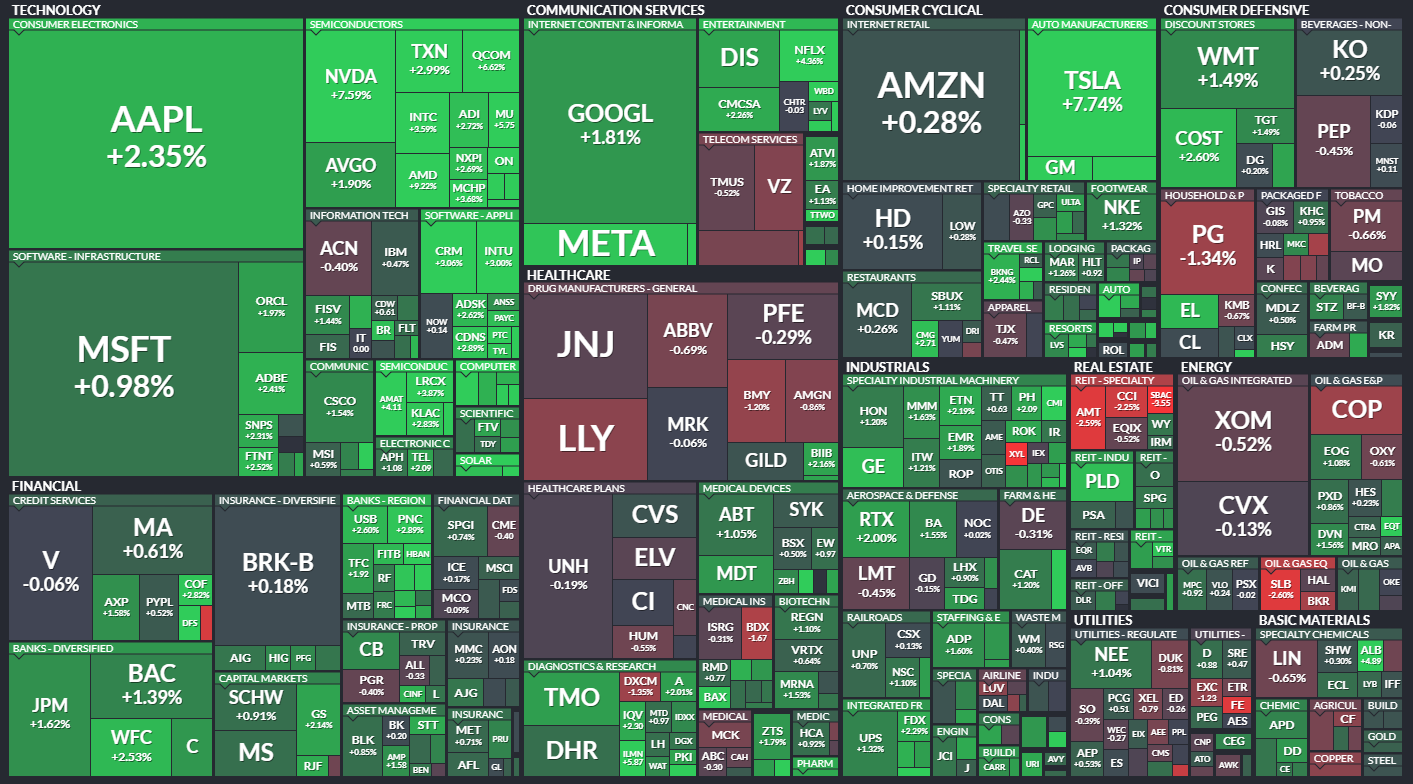Investors remain stuck in the middle of leading economic indicators pointing to recession and the Nasdaq leading the stock market higher — let’s break it all down and see what else you missed today. 👀
Today’s issue covers the top stories in tech, the conference board’s leading economic indicators, and more. 📰
Check out today’s heat map:

Every sector closed green. Technology (+2.31%) led, and utilities (+0.04%) lagged. 💚
Internationally, Japan’s financial troubles continue to intensify as the Bank of Japan struggles to keep yields down. Brazil and Argentina are in talks to further their economic integration by taking steps that include the development of a common currency. And eurozone consumer confidence ticked up modestly in December as their energy prices and economic outlook improved. 🗺️
Caesars Entertainment rose 6% after preannouncing revenue that exceeded expectations. The company will also issue $1.25 billion in senior secured notes. 🎰
Sumo Logic jumped 30% on reports that private equity firms are expressing interest in a buyout. 💰
In crypto news, Binance announced Signature Bank isn’t supporting transactions of less than $100k for its customers. The U.S.’s first nuclear-powered Bitcoin mining center is set to open this quarter. And crypto wallets could be in the crosshairs of major banks which are working on a wallet to compete with PayPal and Apple Pay. ₿
Other symbols active on the streams included: $W (+26.80%), $BYND (+11.31%), $SHOP (+8.79%), $MULN (+2.27%), $GNS (+45.37%), $HLBZ (+109.13%), $XELA (+5.24%), and $COSM (-8.26%). 🔥
Here are the closing prices:
| S&P 500 | 4,020 | +1.19% |
| Nasdaq | 11,364 | +2.01% |
| Russell 2000 | 1,891 | +1.25% |
| Dow Jones | 33,630 | +0.76% |
Stocks
Today In Tech – 01/23/23
Today’s headlines were filled with tech names. We’ll curate the biggest stories so you’re fully up to speed. 📰
First, we’re starting with layoff news. Spotify is the latest tech company to announce it’s trimming its workforce by 6% as it looks to cut costs. The CEO said in a blog post, “Over the last few months, we’ve made a considerable effort to rein in costs, but it simply hasn’t been enough.” and “I was too ambitious in investing ahead of our revenue growth.”
Meanwhile, Gene Munster from Deepwater Asset Management suspects that big tech will reduce its headcount by another 15%-20% in the next six months. ❌
Overexpansion was a serious problem for most tech firms during the pandemic, and now they’re paying the price. Apple has managed to avoid joining the layoff trend, but analysts are not confident it can avoid job cuts entirely.
And employees continue to grapple with a serious change in the environment where they’re gainfully employed one day and being let go the next.
There’s no doubt it’s been a rough two years for tech stocks. While some shareholders are taking the other approach, others are taking action to “force” appreciation into their investment. ⚔️
A prime example of this is Salesforce, which hedge fund Elliott Investment Management just took a substantial activist stake in. They join Starboard Value, which took a stake in the software giant last October, saying its valuation discount was due to a “subpar mix of growth and profitability.” Additionally, Inclusive Capital has a stake in Salesforce, with Jeff Uben reportedly meeting with Marc Benioff Monday.
In miscellaneous tech news, Amazon is launching a dedicated air cargo service in India as its online sales soar. It’s also expanding its partnership with Stripe to accelerate e-commerce and streamline online payments. Apple wants to manufacture 25% of its iPhones in India, up from roughly 5%-7% currently. And Microsoft officially announced its multi-year, multi-billion-dollar investment in the artificial intelligence lab OpenAI. 🤖
Lastly, we’ve discussed the S&P 500 reaching what traders describe as an important resistance level. After the tech-heavy Nasdaq 100’s recent rally, it’s now in a similar position.
The chart below shows the ETF nearing its 200-day moving average. Traders and investors often consider this a measure of a market’s long-term trend. And right now, that indicator is still pointing down. But technical analysts argue that if prices can get above that level, it would be a significant sign that the bulls are retaking longer-term control. 🐻🐂

The Conference Board publishes leading, coincident, and lagging indexes designed to signal peaks and troughs in the business cycle for major global economies. 📝
Today we’re looking at the Leading Economic Index, which made headlines today.
The overall index continued to weaken in December, as expected. It fell 1% following its 1.1% decline in November. That marks a 4.2% drop in the second half of 2022, which was much steeper than the 1.9% contraction in the first half of 2022.
While most of the ten components fell in the second half of 2022, the weakness in non-financial components drove the overall decline. 📉

While these declines were more or less expected, what has investors worried is that the index’s trajectory continues to signal a recession ahead. And while no forecasting system is perfect, this one has a pretty good track record. 🔮

The question now for investors is how bad the recession will be and how long it will last. And if they do figure the economic portion of the puzzle out, what does that ultimately mean for markets? If you can solve that, there’s a lot of money in it for you…
We’ll have to wait and see how things unfold in the first half of 2023. But for now, the trends point to further economic contraction ahead. 😨
Bullets
Bullets From The Day:
👛 Big banks are in your wallet, but now they want to be your wallet. After taking on peer-to-peer payments with Zelle, banks are taking the next step in infiltrating consumers’ behaviors and challenging their fintech peers. According to The Wall Street Journal, the joint venture between the U.S.’s major banks that runs Zelle is preparing a digital wallet to compete with Apple Pay, PayPal, Google Pay, and others. The new wallet plans to launch this year and already have Visa and Mastercard on board. CNBC has more.
🤑 Citadel smashed hedge fund records in 2022. The hedge fund entangled in the meme stock saga is now the most successful ever, making $16 billion in 2022. The massive gain brought its total gains since inception to roughly $66 billion, knocking Ray Dalio’s Bridgewater down from its top spot for the first time in seven years. Last year’s gain even topped John Paulson’s 2007 gain of $15 billion, which had been dubbed ‘the greatest trade ever.’ Overall, the top 20 hedge funds saw their net gains fall 66% YoY after last year’s challenging market environment. More from CNN Business.
🚕 From black cabs to EV powerhouse. China’s Geely is planning a significant investment to turn the maker of London’s iconic black taxis into a high-volume, all-electric brand. London Electric Vehicle Company also aims to expand its suite of services, like cars arranging maintenance and using their owner’s interest to help book activities. However, with its expansion comes additional complexity that companies like Tesla don’t face, as Geely owns multiple brands across vehicle types and countries. Reuters has more.
👨💼 HubSpot co-founder backs a new take on professional networking. LinkedIn has over 875 million users across more than 200 countries. But with that scale came a shifting focus. A new startup Peerlist is trying to get back to basics, allowing professionals a space to find and connect based on their expertise and qualifications. It does this by verifying users’ profile information through work email addresses, diplomas, and other forms of official information. It’s still in the early stages, but the startup has over 20,000 users and has raised $1.1 m million to support its vision. More from TechCrunch.
📆 The first ETF turns 30 years old. Exchange-traded funds are one of the most common investment vehicles that investors and traders use daily. It’s been thirty years since the first ETF was launched, and although the product had a slow start, its growth remains strong. There are now over 2,700 ETFs operating in the U.S., with assets under management of about $7 trillion. While the mutual fund industry is still significantly larger, at $23 trillion, the gap continues to narrow daily. CNBC has more.
Links
Links That Don’t Suck:
💸 Is tipping getting out of control? Many consumers say yes
🌎 Earth’s inner core may have started spinning other way: study
😮 Physicists break record firing a laser down their university corridor
✈️ Delta flight attendant goes viral for comforting nervous woman on flight to JFK
🌬️ Giant wind turbines keep mysteriously falling over. This shouldn’t be happening.
📰 Jeff Bezos may sell Washington Post to buy Commanders, investors say: sources
❌ Supreme Court rejects appeals by ex-Deutsche Bank traders convicted of ‘spoofing’
🍬 Maya Randolph is ‘thrilled’ to take over for M&M’s spokescandies who are on ‘pause’
⚖️ Former top FBI counterintelligence agent Charles McGonigal charged with violating Russia sanctions


